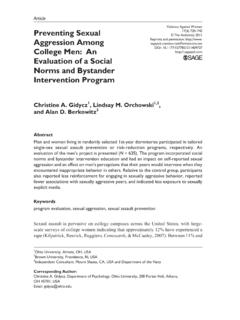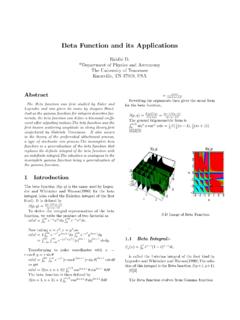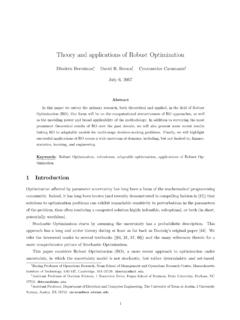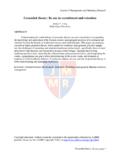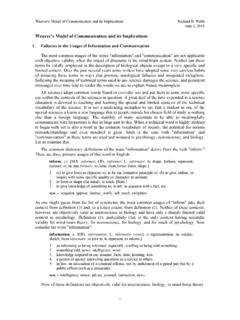Transcription of APPLICATIONS OF SOCIAL NORMS THEORY TO …
1 APPLICATIONS OF SOCIAL NORMS THEORY TO OTHER HEALTH AND SOCIAL JUSTICE ISSUES Alan D. Berkowitz, Trumansburg, Revised, March 2002 Forthcoming as Chapter 16 in The SOCIAL NORMS Approach to Preventing School and College Age Substance Abuse: A Handbook for Educators, Counselors, Clinicians, H. Wesley Perkins, Ed. San Francisco, Jossey-Bass Please do not reproduce this chapter without permission of the author. There is growing interest in the application of SOCIAL NORMS THEORY to issues of SOCIAL justice and to health problems other than alcohol abuse, along with funding of SOCIAL NORMS interventions to address sexual assault and violence prevention by a number of Federal agencies. In light of this interest, this chapter will review the theoretical assumptions of the SOCIAL NORMS approach, assess the relevance of the THEORY to other health and SOCIAL justice issues, and provide examples of SOCIAL NORMS interventions for sexual assault prevention for men, eating problems among women, second-hand effects of binge drinking, and anti-bias programming.
2 SOCIAL NORMS THEORY describes situations in which individuals incorrectly perceive the attitudes and/or behaviors of peers and other community members to be different from their own. This phenomenon has also been called pluralistic ignorance (Miller & McFarland, 1991). These misperceptions occur in relation to problem or risk behaviors (which are usually overestimated) and in relation to healthy or protective behaviors (which are usually underestimated), and may cause individuals to change their own behavior to approximate the misperceived norm (Prentice & Miller, 1993). This in turn can cause the expression or rationalization of problem behavior and the inhibition or suppression of healthy behavior. This pattern has been well documented for alcohol, with college students almost universally overestimating the frequency and quantity of their peers consumption (Perkins et.)
3 Al., 1999). Such misperceptions can facilitate increased drinking and may be used by problem drinkers to justify their own abuse. Similar misperceptions have been documented for illegal drug use (Perkins, 1994, Perkins et. al. 1999), cigarette smoking (Chassin et. al., 1984; Grube, Morgan & McGree, 1986; Sussman et. al., 1988) and eating disorders (Kusch, 2002; Mann et. al., 1997). The research documenting the existence of misperceptions and their role in predicting behavior has been reviewed by Berkowitz (2001A). SOCIAL NORMS THEORY predicts that interventions which correct these misperceptions by revealing the actual, healthier norm will have a beneficial effect on most individuals, who will either reduce their participation in potentially problematic behavior or be encouraged to engage in protective, healthy behaviors. Berkowitz - APPLICATIONS of SOCIAL NORMS THEORY -2 SOCIAL NORMS THEORY can also be extended to situations in which individuals refrain from confronting the problem behavior of others because they incorrectly believe the behavior is accepted by their peer group.
4 That is, individuals who underestimate the extent of peer discomfort with problem behavior may act as bystanders by refraining from expressing their own discomfort with that behavior. However, if the actual discomfort level of peers is revealed, these individuals may be more willing to express their own discomfort to the perpetrator(s) of the behavior. Recent research on homophobia, for example, suggests that most college students underestimate the extent to which their peers are tolerant and supportive of gay, lesbian and bisexual students (Bowen & Bourgeois, 2001). Decreasing the climate of tolerance for problem behaviors is a goal of all prevention programs. Thus, the application of SOCIAL NORMS THEORY to bystander behavior is an additional focus of this chapter. Assumptions of SOCIAL NORMS THEORY As noted, SOCIAL NORMS THEORY predicts that persons express or inhibit behavior in an attempt to conform to a perceived norm .
5 This phenomenon of pluralistic ignorance can cause an individual to act in ways that are inconsistent with their true beliefs and values (Miller & McFarland, 1991). Misperceptions of a norm discourage the expression of opinions and behaviors that are falsely thought to be non-conforming, creating a negative cycle in which unhealthy behavior is expressed and healthy behavior is inhibited. It also allows abusers and perpetrators of problem behaviors to deny or justify their actions due to the (mis)perception that their behavior is normative (Baer, Stacy & Larimer, 1991), a phenomenon called false consensus (Pollard, et al, 2000). This cycle can be broken or reversed by providing individuals with correct information about the actual norm . All individuals who misperceive the norm contribute to the climate that allows problem behavior to occur, whether or not they engage in the behavior.
6 Perkins (1997) coined the term carriers of the misperception to describe these individuals. The assumptions of SOCIAL NORMS THEORY are presented in Table 1. (Insert Table 1 here) The assumptions of SOCIAL NORMS THEORY have been supported by empirical research (Baer et al., 1991; Miller & McFarland, 1987; Perkins & Berkowitz, 1986; Perkins et. al., 1999; Prentice & Miller, 1993) and interventions (Haines & Spear, 1996, Haines, 1996, Johannessen et al, 1999; see also other chapters in this volume) with respect to college student alcohol use (for a recent literature review, see Berkowitz, 2000A). These assumptions lead to a number of questions that can be used to determine the applicability of the THEORY to other health issues, such as eating disorders, sexual health, and sexual assault, or to bystander behavior. Thus, the following questions assess whether a particular health or SOCIAL justice behavior issue is amenable to a SOCIAL NORMS intervention.
7 Berkowitz - APPLICATIONS of SOCIAL NORMS THEORY -3 What misperceptions exist with respect to the behavior in question? What is the meaning and function of misperceptions for individuals and groups? Do the majority of individuals in a group or community hold these misperceptions? Does the target group function as a group with respect to the behavior in question? ( , do the individuals in the group exert an influence on each others behavior?) What is the hypothesized effect of these misperceptions? What changes are predicted if the misperceptions are corrected? What healthy behaviors already exist in the population that should be strengthened or increased? These questions establish the parameters or conditions for health promotion interventions based on SOCIAL NORMS THEORY . If these questions are not adequately addressed, a SOCIAL NORMS intervention may not be appropriate.
8 Keeling (1999) has noted that uncritical application of the model can lead to failed interventions based on incorrect assumptions about students and their behavior. Thus, a critical first step is to determine if a SOCIAL NORMS intervention is appropriate for a particular problem. If a particular problem does meet the criteria outlined above, an intervention can be designed that is appropriate to the target population for the issue in question, taking into account three cultures: the culture of the issue, the culture of the message delivery system, and the culture of the target population (Berkowitz, 1999A). For example, health problems may carry different meanings for specific groups, and these meanings must be addressed when designing an intervention. Native Americans have a unique relationship to the issue of alcohol abuse because of the way alcohol was used as a tool of genocide.
9 Similarly, the meaning of sexual assault among African-Americans has been shaped by the way in which sexual assault was a feature of slavery. In addition, different groups may have different cultural practices regarding the acquisition and dissemination of information. Thus, for a SOCIAL NORMS intervention to be effective, one must take into account the culture of the issue, the culture of the message delivery system, and the culture of the target group, and adapt the intervention to all three. Enthusiasm about the success of the SOCIAL NORMS approach in reducing alcohol use and its negative consequences may also result in the na ve assumption that the same approach can be applied to other issues without changes or adjustments. This would be possible if the etiology and dynamics of other problems were identical to those of substance use and abuse.
10 However, as noted above, each problem has its own history, meaning, and associated culture, and, although the SOCIAL NORMS approach may help address other issues, it cannot be applied indiscriminately or simplistically. The case studies that Berkowitz - APPLICATIONS of SOCIAL NORMS THEORY -4 follow illustrate some of the complexity and limitations of the model as they apply to other issues. Sexual Assault Prevention for Men Sexual assault is an acknowledged problem on college campuses and in communities. Interventions designed to reduce its prevalence either focus on teaching women risk awareness and deterrence strategies to decrease the chances of an assault, or they emphasize men s responsibility for ending violence against women (Berkowitz, 1998A, 2002). Because men are responsible for the overwhelming majority of sexual assaults perpetrated against children, other men, and women, it is reasonable to expect that men should take responsibility for its prevention (Berkowitz, 1992, 2002).



